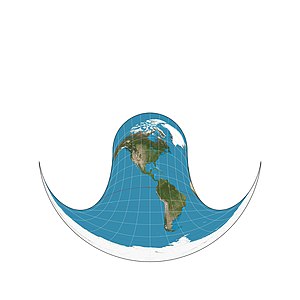Hammer retroazimuthal projection



The Hammer retroazimuthal projection is a modified azimuthal proposed by Ernst Hermann Heinrich Hammer in 1910. As a retroazimuthal projection, azimuths (directions) are correct from any point to the designated center point.[1] Additionally, all distances from the center of the map are proportional to what they are on the globe. In whole-world presentation, the back and front hemispheres overlap, making the projection a non-injective function. The back hemisphere can be rotated 180° to avoid overlap, but in this case, any azimuths measured from the back hemisphere must be corrected.
Given a radius R for the projecting globe, the projection is defined as:
where
and
The latitude and longitude of the point to be plotted are φ and λ respectively, and the center point to which all azimuths are to be correct is given as φ1 and λ0.
See also
References
- ^ Snyder, John P. (1993). Flattening the Earth: Two Thousand Years of Map Projections. Chicago: University of Chicago Press. pp. 228–229. ISBN 0-226-76747-7. Retrieved 2011-11-14.



